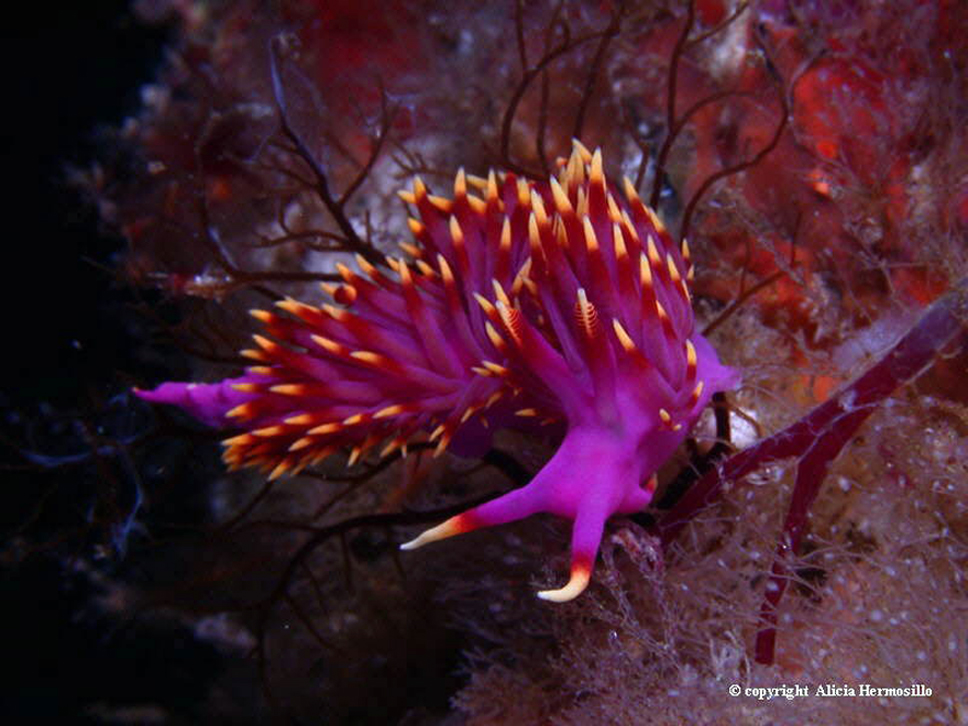 |
Image courtesy of Alicia Hermosillo McKowen
Hermosita sangria Gosliner & Behrens, 1986
Well we had to come up with a new genus for this beauty, as it didn't fit any of the existing genera. Now there are several Hermosita species.
Up to 70 mm in length, the body is a gorgeous violet, which deepens to a rich vermillion midway up the cerata, foot corners, oral tentacles, and rhinophores. The ceratal tips are yellow, or white in some specimens.
Known from Isla Cedros and Isla San Benito, Baja California; Gulf of California, Mexico and Costa Rica
Let me tell you a story. Shortly after the description of this colorful species was published Terry Gosliner and I received a long letter, from Dr. Carlos Risso-Dominguez in Argentina, trashing us over the derivation of the new genus and species names. The name of both the genus and trivial name were suggested by my daughter, Jennifer, who had just returned from an exchange program in Spain. She felt the species colors reminded her of Sangria wine. And Hermosita, in Spanish, means "Little Pretty One." This is all in the etymology portion of the published description. He translated the species name differently, likely in Portuguese, and said it reminded him of the horrors of the Argentine revolution - he translated it as "Little bloody One" even though we explained it differently. He said he was appalled.
Long and short - he complained to the International Commission on Zoological Nomenclature (ICZN) and asked that the name be dropped. They turned him down stating the description and etymology was clear and accurate. Haven't heard from him since.
Reference:
Gosliner, T. M.; Behrens, D. W. (1986). Two new species and genera of aeolid nudibranchs from the tropical eastern Pacific. The Veliger. 29(1): 101-113. [1 July 1986]
Dave Behrens
Sammamish, WA 98074
Jun., 2019
Send Dave Behrens email at davidwbehrens@gmail.com
Send Ali email at aliciahmckowen@gmail.com

Attention all you Sluggers, and you know who you are! The NSSI 2nd edition is now available in ebook PDF and book form . The hard back version will become available Nov. 1st. Both will cost $65 (individually). You will need to jump through a few hoops to get the electronic version as pdf distribution is protected by Adobe ID!! Please read the following to enable reading your electronic purchase! This new 2nd Edition is updated and reorganized, including 185 new species. Among other features, the new edition includes additional photographs of species, an identification key, and an up-to-date classification reflecting the latest evolutionary relationships. The Indo-Pacific represents the largest expanse of tropical ocean in the world, stretching from the Indian Ocean coast of southern Africa and the Red Sea to the central Pacific of the Hawaiian Islands, Easter Island and the Marquesas. This region supports the most diverse marine fauna of any place in the world for most groups of marine organisms. The nudibranchs and sea slugs are no exception to this rule; there are about 3,000 described species of these organisms in the world and at least 40% of these have been found exclusively in the Indo-Pacific tropics. This book illustrates 2,138 Indo-Pacific nudibranchs and sea slugs, including many undescribed species.
|

|
